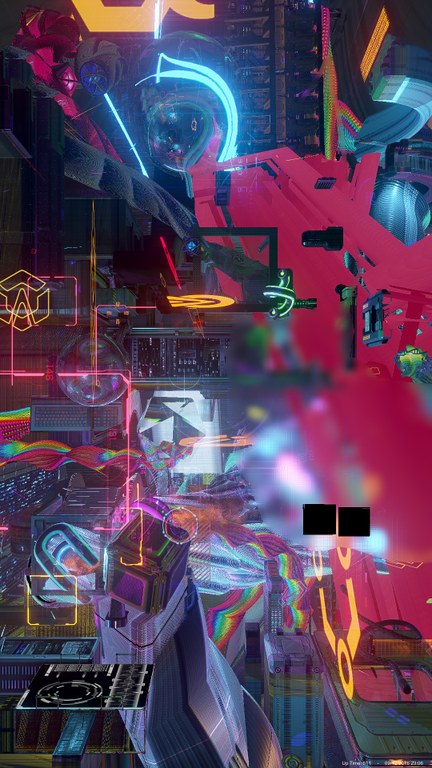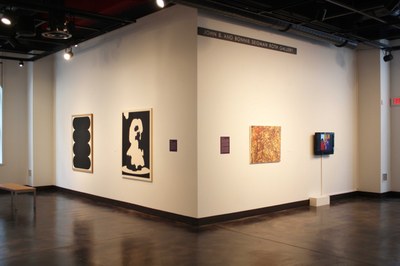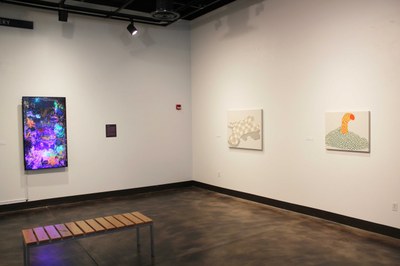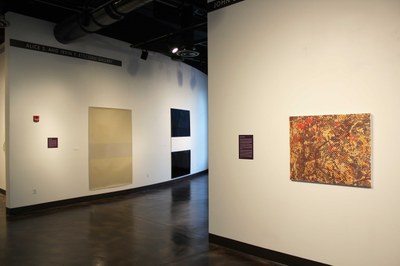Painting in the Network: Algorithm and Appropriation
Tabor Robak, Darkroom (still), 2016, generative animation on custom PC, dimensions variable, AP1, Edition 3/3, 2 APs. Courtesy of the artist and Team Gallery, New York

Cressman Center for Visual Arts
On View: February 10 - April 8, 2017
Reception: February 10, 2017 6-8 PM
The Hite Art Institute is pleased to announce the opening of “Painting in the Network: Algorithm and Appropriation,” an exhibition of seven contemporary artists whose work explores the intersection between painting and digital technology.
“Painting in the Network” is an exhibition about painting, even though roughly half of the work on display isn’t painting at all. Instead, this artwork is painterly—that is, it takes up certain formal painting devices (like color theory, modeling, and single point perspective), and it elaborates certain painterly tactics originally developed by the 19th and 20th century avant-garde. Artists in the exhibition are concerned with how such painterly traditions survive—and even thrive—in the digital age. Tabor Robak, for example, writes elaborate computer programs that produce never-ending digital compositions. His Darkroom (2016) looks like a large hanger on a spaceship as seen through an endlessly moving, living windowpane. Although his images look like they belong to a videogame, they also maintain an obvious tension between illusionary space and surface, material and subject—aesthetic and compositional concerns that affirm his work is part of the long history of modern painting.
Alex Dodge’s work is more explicitly painterly; indeed, his artworks are paintings. But they are no less technologically oriented than Robak’s. Dodge’s work often begins on a computer. He scans real objects into a program via a 3D scanner or makes his own virtual objects using a 3D modeling program. He then creates elaborate textile-like patterns in 2D design software and imports them into the 3D modeling environment. Finally, using an algorithmic simulation called a “physics engine” (software that recreates the laws of real world physics) he drapes the cloth construction over the 3D object. He then translates the compound image to canvas via a laser-cut stencil and oil paint.
In every case, these artworks take up painterly tactics of “deskilling,” modernist techniques that outsourced the composition of painting to a third party. Such tactics historically included appropriation (the gesture to steal an image or object from popular culture) as well as chance operations; for example, dropping cut paper from a certain height onto a support in order to let gravity compose the work of art. The goal for the historical avant-garde was to connect artistic work with labor generally. Those artists wanted to take art making out of the hands of experts and put it into the hands of everyone.
Much of the work on display in “Painting in the Network” involves outsourcing composition too, although in these cases to an algorithm or a program. Gabriel Orozco’s animation video, for example, demonstrates how his Samurai Tree paintings are made according to a complex rule involving the moves of the Knight chess piece. However, in this work “deskilling” operations look more like “reskilling.” That is, most of these artists are very talented computer programmers—talent evidenced by their elaborate digital compositions and sophisticated algorithms. By “outsourcing” the job of composition to a program that they write, these artists retool and reboot their artistic labor.
“Painting in the Network” includes work by Siebren Versteeg, Gabriel Orozco, Cory Arcangel, Tabor Robak, Davis Rhodes, Laeh Glenn and Alex Dodge. It is on view from February 10 through April 8.
image: Tabor Robak, Darkroom (still), 2016, generative animation on custom PC, dimensions variable, AP1, Edition 3/3, 2 APs. Courtesy of the artist and Team Gallery, New York
 |
 |
|---|---|
 |
 |

 Instagram
Instagram Facebook
Facebook Pinterest
Pinterest Twitter
Twitter